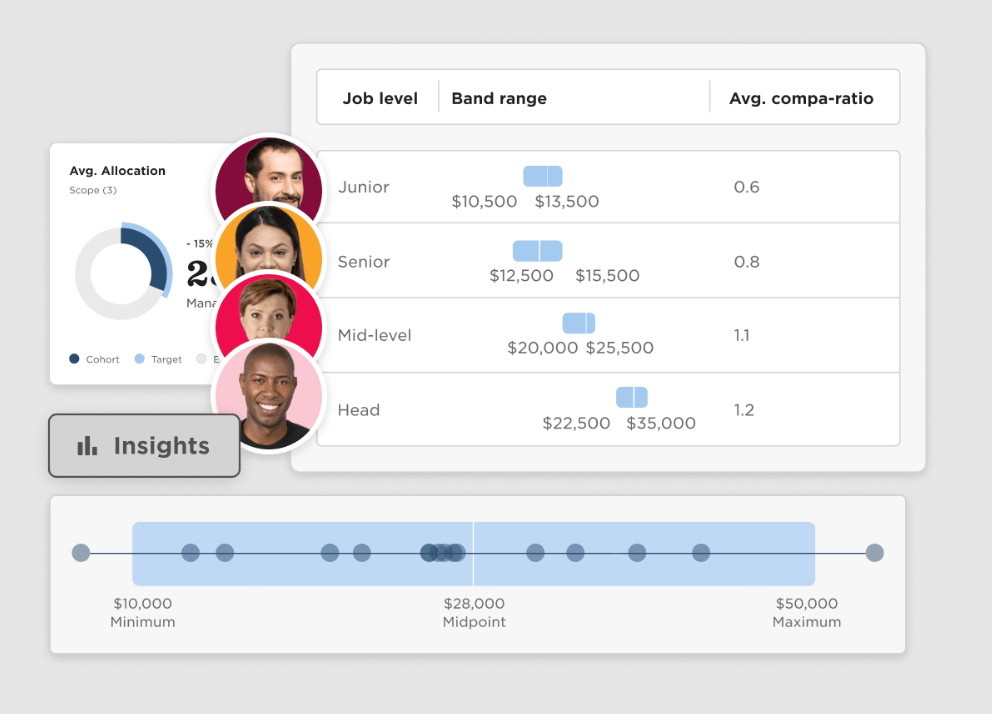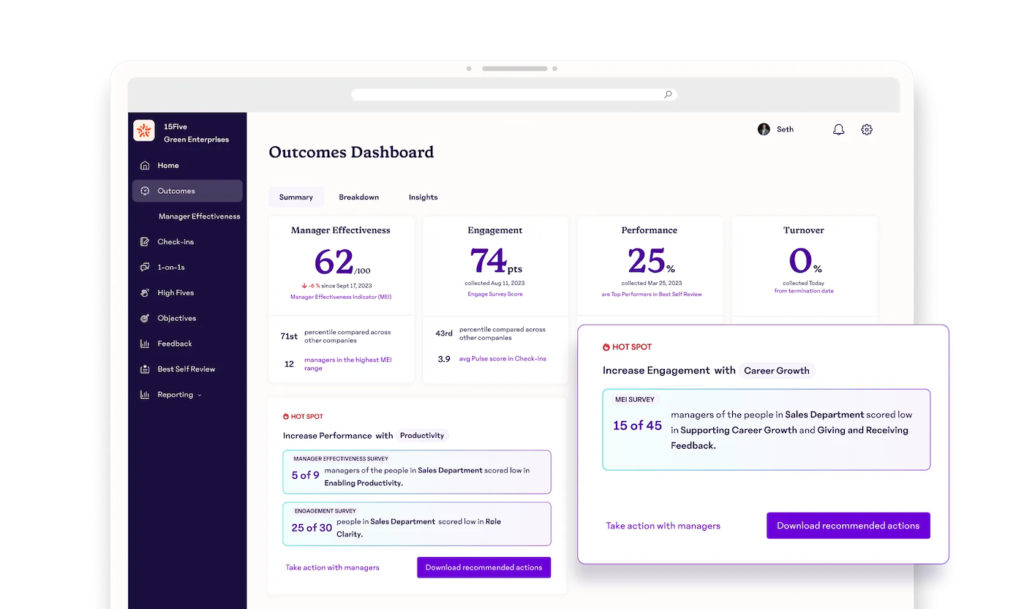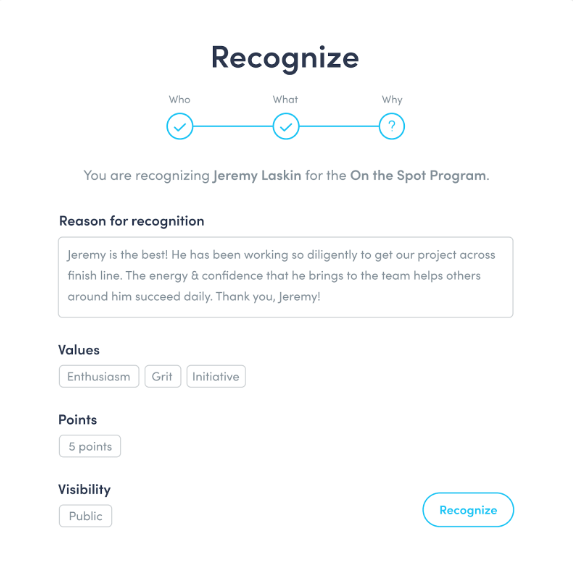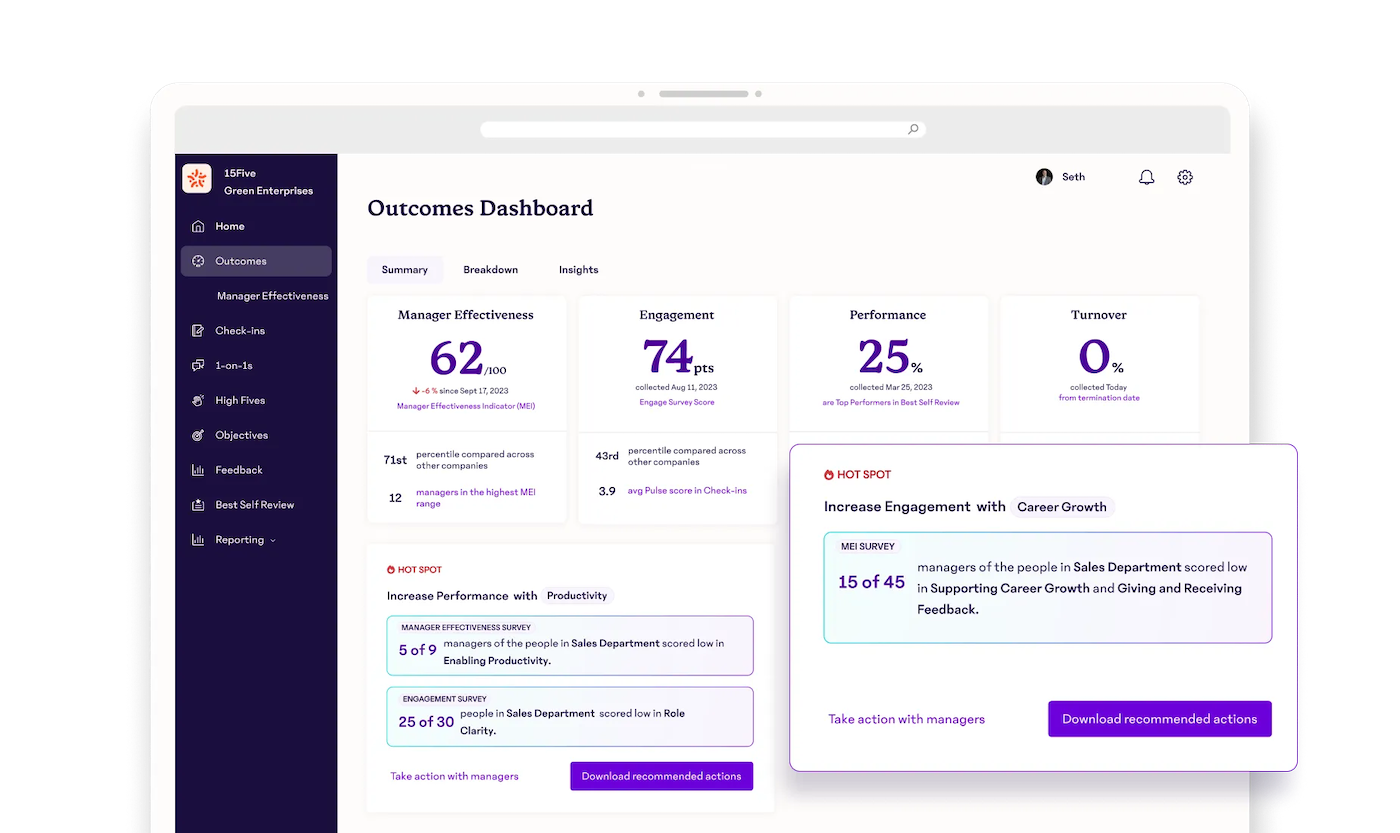Top Employee Retention Strategies for 2024
Key takeaways
Employee retention is increasingly challenging, but employers that adopt a holistic approach, such as improving benefits, offering flexible work, and rewarding and recognizing employees, could significantly reduce turnover. An effective retention plan should include clear goals and the metrics you’ll use to track progress toward them. Employee feedback plays a crucial role in retention efforts, as it provides insights into what employees value and the changes they’d like to see in the workplace.
- Nov. 22, 2024: Rebecca Noori revised the copy by adding new retention strategies, software recommendations, and fresh data according to the latest trends. She also added depth to the steps required to create your own retention strategy, including relevant questions and metrics.
As an HR and workforce management writer, I have a deep understanding of employee retention and how it supports organizations and individuals in reaching their full potential. I use industry data from leading industry bodies such as Gallup and LinkedIn, combined with practical knowledge from speaking to people leaders about their approach to retention.
11 employee retention strategies at a glance
It’s not easy for companies to hang onto their workers. The Achievers’ Engagement and Retention report reveals that only 35% of employees plan to remain with their employers this year. Further, 41% of respondents confirmed they would actively seek a new role, while 24% were unsure, suggesting the right opportunity could sway them.
The numbers seem discouraging, but it’s natural for your people to move on at some point. Nevertheless, several strategies exist to lengthen the employee lifecycle and reduce the cost of recruiting new talent:
1. Enhance your total compensation package
According to the same Achievers report, compensation is the most common reason for leaving a job in 2024. This term refers to everything employees receive in exchange for their time, labor, and skills. Typically, total compensation includes:
- Annual salary.
- Core employee benefits like health insurance and retirement planning.
- Employee perks such as mental health and wellness programs.
- Bonuses or performance-based incentives.
- Paid time off and vacations.
Ensure your offering is competitive in the market and geographic area by comparing your package with rivals. If other employers promise higher wages, more PTO days, or a better tier of health insurance, it’s understandable you might be losing people.
HR software like HiBob analyzes salary data against internal and external benchmarks. A consistent, transparent compensation strategy ensures that everyone is being paid fairly and competitively.

Learn more about total compensation
Check out our salary and benefits articles for actionable advice to enhance your total compensation offerings:
2. Provide role clarity
When employees understand the scope of their role, including its tasks and responsibilities, they’re more likely to feel engaged in their work and less inclined to leave the company. Unfortunately, Gallup’s research finds only 45% of employees are clear about the expectations of their role.
If this is a problem in your organization, take steps to:
- Provide comprehensive job descriptions, including the skills, competencies, and experience required for each role in your organizational chart.
- Encourage accountability by discussing expectations within your teams.
- Foster open communication by inviting questions or concerns and being clear about reporting structures.
- Highlight clear pathways from an employee’s current role to their dream position, using the promise of internal mobility to encourage retention.
3. Invest in employee development
When employees know their company is committed to their professional growth, they’re less likely to seek career opportunities elsewhere. LinkedIn’s Workplace Learning report finds this is the fifth highest priority for L&D professionals this year.
There are numerous ways to upskill your employees, including:
- On-the-job training where employees work on real tasks with feedback from supervisors or peers.
- Online courses that are self-paced and suitable for remote teams.
- In-person seminars, workshops, or conferences, in case employees prefer classroom-based learning.
- Learning management systems (LMS) for customized development programs that align individual growth opportunities with the company’s business goals.
As an example of an LMS, 360Learning identifies the skills and competencies required for each role and then monitors each employee’s skills progression. This level of transparency gives employees greater control over their own development, and managers can make objective decisions when team members are ready to advance to new internal roles.

4. Offer mentoring and coaching opportunities
Alongside formal learning, partnering employees with a human-sounding board can effectively keep them focused on their growth. A coach is usually a qualified professional who offers regular sessions to help employees progress in their careers. However, you may also train managers to act as coaches, supporting their direct reports to reach individual goals.
Mentoring is more relaxed, often pairing a more experienced professional with a junior colleague. In successful mentoring partnerships, both parties will benefit from the arrangement; the mentee receives the support and expertise of a seasoned professional, while the mentor improves their leadership and communication skills.
The challenge of mentoring is finding the right person for each mentee. Mentorloop is a platform that smart-matches employees or empowers them to self-organize their own matches. Once paired, the software guides the relationship with contextual nudges to keep employees moving toward goals.

5. Build a supportive feedback culture
Employees who receive meaningful feedback from their managers and peers feel more connected to their role and overarching organization. The more frequent the feedback, the better; Gallup reports that 80% of employees who receive feedback weekly are engaged in their work, which will likely positively impact retention.
Software like 15Five supports a culture of continuous feedback by elevating performance in just fifteen minutes each week. Managers can set up objective assessments to evaluate employees without performance biases creeping in, then leverage the actionable insights from employee surveys to improve their own effectiveness as leaders.

6. Identify clear complaint procedures
Companies with open communication practices invite positive and constructive feedback from employees, understanding that workers at all levels have valuable insights to share. In the case of complaints, employees should be able to follow a set process to raise any issues and have their voices heard.
You should customize the process according to your HR workflows, compliance regulations, and overall company culture. As an example, this might involve:
- Asking the employee to draft a written complaint outlining the situation in question and its impact on their work or wellbeing.
- Addressing this with their direct manager or HR team.
- Conducting a review to decide if further action is necessary, including an investigation and potential disciplinary measures.
- Documenting the results, including any action points.
7. Take action on employee survey results
Surveying your employees regularly helps you assess their engagement levels and work experiences so you can address any issues that could impact retention.
But giving feedback takes effort for employees. Whether they’re filling out another survey or following a complaints procedure, it takes time and energy for them to offer thoughtful insights. They’ll quickly tire of the process if they don’t believe there’s anything in it for them.
I recommend that you prove you’re interested in their point of view by taking appropriate action toward creating a positive work environment, perhaps by:
- Hosting focus groups or open forums where employees can discuss concerns.
- Creating task forces or committees to improve specific areas of concern.
- Implementing new policies or procedures to address common issues.
8. Create opportunities for employees to feel included
64% of employees feel it’s important to work for an organization with a mix of different races and ethnicities (32% say it’s extremely or very important, 30% say it’s somewhat important). An equal number of people feel the same way about working alongside colleagues of a range of ages, according to Pew Research.
However, diversity, equity, inclusion, and belonging (DEIB) is about more than just checking a demographics box. To retain employees of any background, you need to create a working environment where everyone feels welcome and valued.
One way to foster inclusion is by creating employee resource groups (ERGs) that provide a safe space for employees from marginalized or underrepresented groups to connect and support one another. These groups also serve as a source of feedback for the company on how to improve diversity, equity, and inclusion initiatives, for example, by celebrating cultural holidays and events or offering diversity training.
9. Prioritize a strong employee experience
The inclusion part of DEIB starts with a strong onboarding process that sets the tone for a positive employee experience. It might seem surprising that people who have recently joined your organization would consider departing so soon, but Nectar’s research highlights that 29% of workers have quit a job within 90 days of starting.
Retain your employees for much longer by designing an onboarding program using a dedicated program like Enboarder, which:
- Encourages social connections and relationship-building with teammates.
- Communicates the company’s goals, values, and expectations clearly.
- Uses bite-sized prompts, enabling employees to ramp up and become productive.
- Nudges managers to reach out at pivotal moments.

10. Foster a healthy work-life balance
Gallup’s State of the Global Workplace report finds that employee well-being has declined from 35% to 34%. In particular, isolation is a problem, with 22% of the world’s working population feeling lonely every day—this is even higher in remote employees (25% compared to 16% in on-site workers).
Employers that support their people with their physical and mental health are more likely to retain them over the long term. I suggest you take steps like:
- Modeling healthy boundaries between work time and personal time; for example, not sending emails or direct messages to people outside of business hours.
- Offering flexible working arrangements such as remote work or compressed hours where feasible.
- Providing access to mental health resources, such as counseling or therapy services.
- Promoting wellness initiatives like physical activity or mindfulness practices.
- Implementing team workload management strategies to prevent burnout and promote productivity.
11. Recognize and reward employee contributions
It’s human nature to crave praise and acknowledgment for our efforts at work. When managers and peers take the time to express appreciation, this reinforces the behavior and ensures the employee feels valued. This has a powerful impact on retention: a recent Gallup study conducted between 2022 and 2024 found that employees who received high-quality recognition for their work were 45% less likely to leave over the two years.
Employee recognition software such as Awardco makes launching, maintaining, and growing your rewards program easier. Employees receive points within the Awardco platform via social recognition, goal achievements, and service milestones, which they can redeem for rewards like tangible gifts, company swag, gift certificates, and experiences.

5 reasons employees leave
Companies lacking a robust retention strategy experience some commonalities as employees head for the exit. Achievers’ Engagement and Retention report lists some of the top issues:
- Inadequate compensation: 32% of employees seek better pay and corporate benefits from an alternative employer.
- Limited growth opportunities: Career progression is the second most popular reason to leave a job—24% choose this as a key decision factor.
- Workplace flexibility: Companies failing to offer remote work or flexible hours cause 23% of employees to move on. Organizations executing return-to-office (RTO) mandates likely fall into this category.
- Company culture: Factors like culture and values fit were a reason for 12% of people to remain with an employer, while a sense of belonging swayed 13%.
- Manager relationships: Perhaps the most surprising—only 3% of employees chose to leave an employer due to their relationship with a manager, while 8% cited this bond as a reason to remain.
How to create your own employee retention strategy
Follow the steps below to create a retention strategy from scratch or revamp any existing initiative you have to retain talent.
1. Analyze your current turnover data
Understand your current situation by benchmarking your turnover data. You might analyze how many people have left your organization in the past three to six months and use this as your starting point.
I recommend the following formula:
Employee turnover rate = Number of employees who left during the past quarter divided by Average number of employees during the same period multiplied by 100
Example: If 20 employees left during the quarter and your average number of employees was 200, the turnover rate would be 20/200 x 100 = 10%
As you build and roll out your new retention strategy, you can measure progress against this initial baseline.
Ready to build a more engaged, loyal workforce? Discover these 6 Strategies to Reduce High Employee Turnover + Free Calculator.
2. Set goals for your retention strategy
Know “why” you want to develop a retention strategy. This should go beyond the obvious notion of “to retain talent” and link back to your business goals.
I’m a huge fan of the SMART framework, which helps you select specific, measurable, achievable, relevant, and time-bound goals. For example, if my organization was struggling with employee turnover, I might create the following SMART goal:
“Our company will reduce employee turnover from 18% to 15% by the end of Q4 2024 through enhanced career development and competitive compensation strategies. These should boost productivity and cut recruitment and onboarding costs by $50,000 annually.”
This goal is:
- Specific: The goal includes details of how I plan to improve team productivity and decrease the costs of recruiting and training new hires.
- Measurable: I’ll use turnover metrics to assess the progress of the goal.
- Achievable: 12 months is a reasonable amount of time to execute the strategy and notice tangible results.
- Relevant: The goal ties to our business objective of saving resources and offering an exceptional employee experience.
- Time-bound: I have a clear deadline to work toward.
3. Conduct stay and exit interviews
Data is an important way to measure the success of any retention strategy, but it doesn’t tell the whole story. Every person who voluntarily leaves or remains with your company has made that decision for a reason. Metrics may help you spot trends, but conducting in-person stay and exit interviews will reveal what motivates employees to choose one path over another.
Exit interviews are held during the last three to five days of an employee working with you as part of their offboarding. Although your team member has already decided to leave, showing care and interest in them at this stage may even result in boomerang employees who rejoin the company later. Ask questions like:
- How does your new position align better with your personal objectives (compensation, culture fit, etc.) than this one?
- What would have made your experience better here?
- Can you describe a particular event that swayed your decision to leave?
Deciding when to host stay interviews is less clear. Some companies I’ve worked with choose to hold them as part of the annual performance review, while others host reactive check-ins following anything unsettling like layoffs or mergers.
Whatever your cadence, consider a range of questions like:
- What makes you excited to work at this company, and what keeps you here?
- How does your current role align with your long-term career goals?
- How do you feel about your current work-life balance?
4. Identify retention opportunities
Based on the quantitative data you’ve collected, combined with qualitative human insights from your interviews, spot any trends to act on.
Example: You may notice an uptick in people leaving for upskilling opportunities with a rival organization. If this is the case, you’ll know to invest more in learning and development programs to entice your employees.
5. Develop tailored retention initiatives
The solutions to your retention problems will require targeted initiatives that often require stakeholder sign-off. Some examples could include:
- Offering a retention bonus: A financial incentive that your employees take home in exchange for remaining with the company for an agreed period, such as two to five years.
- Promoting career development opportunities: The chance to upskill or move around within the organization.
- Providing flexible work arrangements: Remote work or flexible hours can improve work-life balance.
- Improving company culture: This can range from addressing toxic behavior to promoting a more inclusive environment for all employees.
6. Measure progress toward your retention goal
Track some of the following metrics to monitor progress toward your retention goals. These might include:
- Employee feedback, including stay interview data to understand if sentiment is improving across your organization.
- Employee turnover and retention data, compared to the benchmarks you collected in Step 1.
- Cost savings from reduced attrition or turnover and the implementation of retention initiatives.
- Employee productivity and engagement levels, using metrics like absenteeism and performance ratings.
- Employer net promoter score (eNPS) to measure overall satisfaction and loyalty within your workforce.
- Employee referral rates to indicate if employees are actively promoting your company as a great place to work.
7. Refine your strategy
Employee retention isn’t a one-time project. To hang onto your top talent and reduce the cost of recruiting, onboarding, and training new hires, you’ll need to commit to your retention strategy over the long term.
Keep tracking your data, collecting human insights, and refining your strategy in response to the latest trends.
Employee retention FAQs
Retaining workers is essential for maintaining productivity, reducing costs, and promoting a positive company culture. When the opposite happens, employee turnover can result in decreased morale, loss of knowledge and expertise, and increased expenses for hiring and training new employees.
An employee’s decision to remain with a company is entirely personal. What convinces one person to stay may not work for another. However, some common drivers of retention include career development opportunities, competitive compensation and benefits, a positive company culture, and work-life balance.
The three R’s of employee retention are respect, recognition, and rewards. Together, these contribute to a positive work culture where employees feel valued and motivated to stay with the company. Fail to offer these, and you’ll face an unwanted R—recruitment.
Featured partners
The post Top Employee Retention Strategies for 2024 appeared first on TechnologyAdvice.














